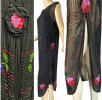The story of Chicago is actually based on true events—trials that occurred in the mid-1920s, covered by journalist Maurine Dallas Watkins. The intrigue and scandal of women on trial for homicide became so popular that Watkins wrote a book and a play that ran for over 170 performances.
By the late 1960s, Gwen Verdon urged her husband Bob Fosse to get the rights to bring the production to Broadway. The show opened in June of 1975 with Verdon playing the role of the youthful spitfire Roxie Hart and Chita Rivera playing her older vaudeville counterpart Velma Kelly. The show ran until 1977 and did not resurface until the 1996 revival, with Broadway legends Ann Reinking and Bebe Neuwirth taking the helm of Velma and Roxie, respectively. In 2002, Catherine Zeta-Jones and Renée Zellweger strapped on their beaded dresses and fishnets for the theatrical production alongside Richard Gere and John C. Reilly.
With Fosse’s touch, Chicago has been a darling of Broadway and has taken second place as the longest-running Broadway production, directly behind The Phantom of the Opera. This month, we celebrate its 50th anniversary.
What keeps audiences coming back? The themes of Chicago—corruption, and our fascination with celebrity through crime—are expressed through Fosse’s choreography and the juxtaposed snappy yet haunting soundtrack.
The fashion, on the other hand, straddles the masculine and feminine during the decade when women were discovering their independence and sexuality. The production uses scantily clad, lingerie-like flapper dresses with fluid fringe and heavy beading to bring the Roaring Twenties to life. In other numbers, top hats, tuxedo jackets, and tailored suits personify the crossing of gender barriers. The men’s fashion is mostly subdued, with simple pinstripe or grey gabardine suits. They fall into the shadows, keeping your focus on Velma and Roxie, who demand your attention in a palette of black with splashes of deep red, silver, and gold.
This month, let’s celebrate your inner Velma, the more refined and mature woman who knows the game because she wrote the rules:
- Sheer, beaded, fringed dresses that move fluidly with the body
- Fur-trimmed coats
- Cloche hats
- Long, beaded necklaces
- Top hats, tuxedo jackets
- Shorter, bold-colored, sparkled dresses worn with fishnets
- Youthful, collared dresses
- Fedoras
- Feather-trimmed garments
- Gold or silver shoes


